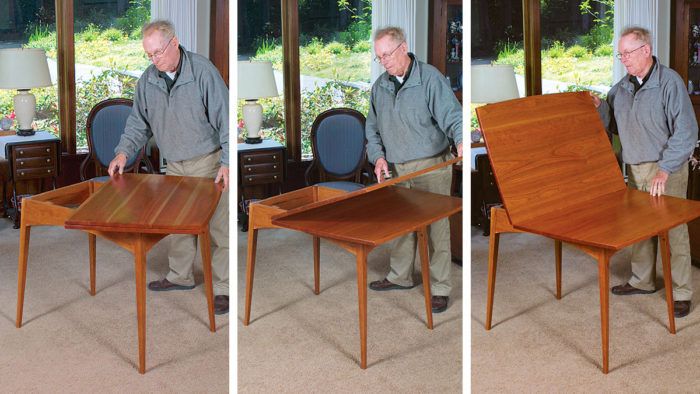An Expandable Table
With a twist and a flip, a table for two becomes a table for six.

Synopsis: William Krase brings his aerospace engineering skills into play in designing a versatile table — small enough to seat two, expandable to seat six, yet more functional than a drop-leaf table and easier to set up. His idea incorporates a base stable enough for both sizes of tabletop, but it isn’t so big that it gets in the way of users’ feet.
I vividly remember the colorful language my mother used when I was a kid as she struggled to extend a removable-leaf table that was prone to jamming. So when a client asked for an expandable table, I sought a better solution. An apartment dweller, my client wanted a table that would fit against a wall and seat two and that could on occasion be expanded to seat six. He expected some sort of drop-leaf table, but it’s difficult to sit around that kind of table when the leaves are down.
I recalled seeing a table where the top pivoted and then unfolded to double in size, a solution I thought would meet the needs of my client. The design meets several challenges inherent in this type of table. The central problem is that a fixed base must accommodate, with adequate stability, both a small top and one that is twice the size. At the same time, the footprint of the base should not extend beyond the “shadow” of the hinged top in its contracted size, lest the legs of the table conflict with the feet of the user.
The use of Soss hinges permits the leaf to fold over 180° in the closed position. When the table is open, though, the hinges are concealed. Two would have given enough strength, but I elected to use four hinges to help keep the leaves aligned.
The folding method I used is suitable for larger tables with a length-to-width ratio of 1.2 to 1.8, but it is not suitable for square round, or oval tabletops. I made the open table boat-shaped, a design that affords everyone a better view of each other and that is conducive to conversation. The edge profile must take into account the sometimes-inverted position of one leaf. I used a simple long-radius roundover bit guided by a template.
I chose to splay the legs for extra stability and to taper them all the way to the bottom. The ends of the aprons are all 5° from the vertical with the tenons cut on the tablesaw using a jig I described in FWW #99, pp. 44-45 (or visit www.finewoodworking.com). Strictly speaking, the tenons should have been cut at a compound angle due to the splay of the legs, but I didn’t do this because the second angle for a 5° splay is a negligible 0.2°. Make a scale drawing to locate the position of the pivot point (above).
For the full article, download the PDF below:







Log in or create an account to post a comment.
Sign up Log in